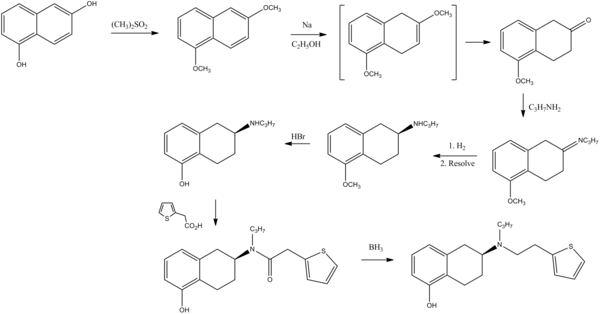Rotigotine
 | |
| Clinical data | |
|---|---|
| AHFS/Drugs.com | Micromedex Detailed Consumer Information |
| MedlinePlus | a607059 |
| Pregnancy category |
|
| Routes of administration | Transdermal patch |
| ATC code | |
| Legal status | |
| Legal status |
|
| Pharmacokinetic data | |
| Bioavailability | 37% (transdermal) |
| Protein binding | 92% |
| Metabolism | Hepatic (CYP-mediated) |
| Elimination half-life | 5–7 hours |
| Excretion | Urine (71%), Fecal (23%) |
| Identifiers | |
| |
| CAS Number | |
| PubChem CID | |
| IUPHAR/BPS | |
| DrugBank | |
| ChemSpider | |
| UNII | |
| ChEMBL | |
| CompTox Dashboard (EPA) | |
| ECHA InfoCard | 100.123.257 |
| Chemical and physical data | |
| Formula | C19H25NOS |
| Molar mass | 315.474 g/mol g·mol−1 |
| 3D model (JSmol) | |
| |
| |
| | |
Rotigotine (Neupro) is a dopamine agonist of the non-ergoline class of medications indicated for the treatment of Parkinson's disease (PD) and Willis-Ekbom Disease#REDIRECTRestless Legs Syndrome (WED)formerly known as restless legs syndrome (RLS) in Europe and the United States.[1][2] It is formulated as a once-daily transdermal patch which provides a slow and constant supply of the drug over the course of 24 hours.[1][1]
Like other dopamine agonists, rotigotine has been shown to possess antidepressant effects and may be useful in the treatment of depression as well.[3]
History
Rotigotine was developed by Aderis Pharmaceuticals. In 1998, Aderis licensed worldwide development and commercialization rights for rotigotine to the German pharmaceutical company Schwarz Pharma (today a subsidiary of the Belgian company UCB S.A.).[4]
The drug has been approved by the EMEA for use in Europe in 2006 and is today being sold in several European countries. In 2007, the Neupro patch was approved by the Food and Drug Administration (FDA) as the first transdermal treatment of Parkinson's disease in the United States. However, as of 2008, Schwarz Pharma has recalled all Neupro patches in the United States and some in Europe because of problems with the delivery mechanism. The patch was reformulated, and was reintroduced in the United States in 2012.[5]
Rotigotine has been authorized as a treatment for restless legs syndrome since August 2008.[2]
Chemistry
Rotigotine is analogous to 7-OH-DPAT and UH-232, all three of which are aminotetralin derivatives. These compounds are similar in structure to dopamine, likely underlying their pharmacology.
Cusack, N. J.; Peck, J. V.; Drugs Future 1993, 18, 1005.
Pharmacology
Rotigotine possesses the following in vitro receptor binding profile:[6]
|
|
|
All affinities listed were assayed using human materials except that for α2B-adrenergic which was done with NG 108–15 cells. Rotigotine behaves as a partial or full agonist (depending on the assay) at all dopamine receptors listed, as an antagonist at the α2B-adrenergic receptor, and as a partial agonist at the 5-HT1A receptor.[6] Though it has affinity for a large number of sites as shown above, at clinical doses rotigotine behaves mostly as a selective D2-like (D2, D3, D4) and D5 receptor agonist, with its α2B-adrenergic and 5-HT1A activity also possibly having some low relevance.
Side effects
General side effects for rotigotine may include constipation, dyskinesia, nausea, vomiting, dizziness, fatigue, insomnia, somnolence, confusion, and hallucinations.[7][8] More serious complications can include psychosis and impulse control disorders like hypersexuality, punding, and pathological gambling.[9] Mild adverse skin reactions at the patch application site may also occur.[1][8]
See also
References
- ^ a b c d Chen JJ, Swope DM, Dashtipour K, Lyons KE (2009). "Transdermal rotigotine: a clinically innovative dopamine-receptor agonist for the management of Parkinson's disease". Pharmacotherapy. 29 (12): 1452–67. doi:10.1592/phco.29.12.1452. PMID 19947805.
{{cite journal}}: Unknown parameter|month=ignored (help)CS1 maint: multiple names: authors list (link) - ^ a b Davies S (2009). "Rotigotine for restless legs syndrome". Drugs of Today (Barcelona, Spain : 1998). 45 (9): 663–8. doi:10.1358/dot.2009.45.9.1399952. PMID 19956807.
{{cite journal}}: Unknown parameter|month=ignored (help) - ^ Bertaina-Anglade V, La Rochelle CD, Scheller DK (2006). "Antidepressant properties of rotigotine in experimental models of depression". European Journal of Pharmacology. 548 (1–3): 106–14. doi:10.1016/j.ejphar.2006.07.022. PMID 16959244.
{{cite journal}}: Unknown parameter|month=ignored (help)CS1 maint: multiple names: authors list (link) - ^ Development & Commercialization of rotigotine by Aderis (Aderis Pharmaceuticals making a reference for the commercialization of rotigotine)
- ^ Neupro Patch Re-launches in the US
- ^ a b Scheller D, Ullmer C, Berkels R, Gwarek M, Lübbert H (2009). "The in vitro receptor profile of rotigotine: a new agent for the treatment of Parkinson's disease". Naunyn-Schmiedeberg's Archives of Pharmacology. 379 (1): 73–86. doi:10.1007/s00210-008-0341-4. PMID 18704368.
{{cite journal}}: Unknown parameter|month=ignored (help)CS1 maint: multiple names: authors list (link) - ^ Kulisevsky J, Pagonabarraga J (2010). "Tolerability and safety of ropinirole versus other dopamine agonists and levodopa in the treatment of Parkinson's disease: meta-analysis of randomized controlled trials". Drug Safety : an International Journal of Medical Toxicology and Drug Experience. 33 (2): 147–61. doi:10.2165/11319860-000000000-00000. PMID 20082541.
- ^ a b "A controlled trial of rotigotine monotherapy in early Parkinson's disease". Archives of Neurology. 60 (12): 1721–8. 2003. doi:10.1001/archneur.60.12.1721. PMID 14676046.
{{cite journal}}: Unknown parameter|month=ignored (help) - ^ Wingo TS, Evatt M, Scott B, Freeman A, Stacy M (2009). "Impulse control disorders arising in 3 patients treated with rotigotine". Clinical Neuropharmacology. 32 (2): 59–62. doi:10.1097/WNF.0B013E3181684542. PMID 18978496.
{{cite journal}}: CS1 maint: multiple names: authors list (link)

